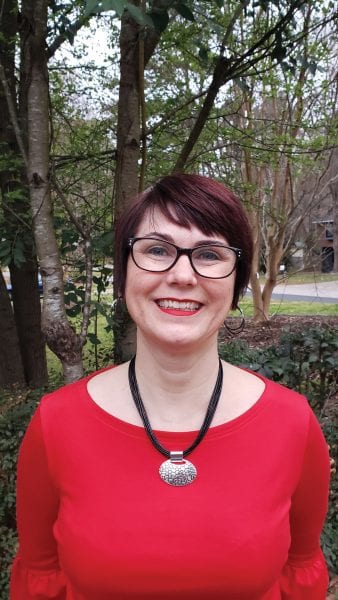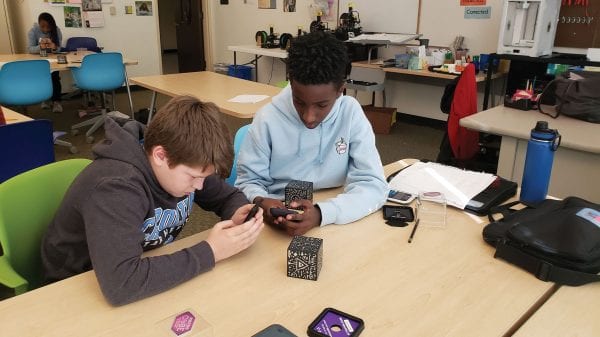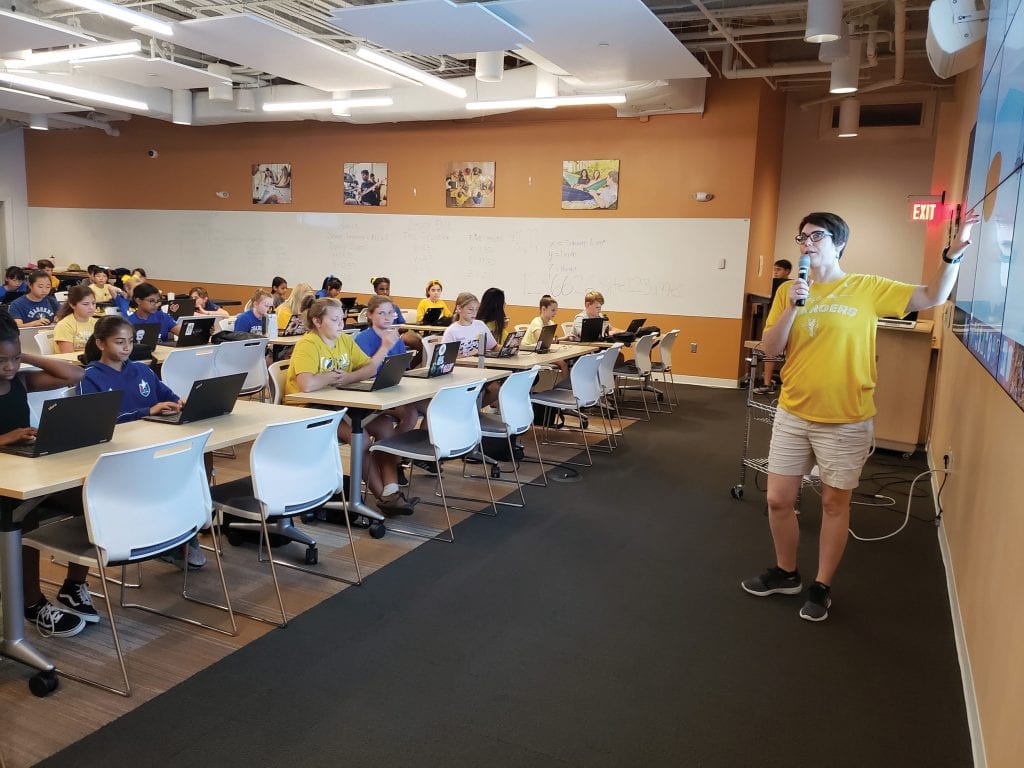Though innovation and technology are often used interchangeably when talking about education, at CA, educational technology—EdTech, for short—is one of many tools that our faculty use to create personalized learning opportunities that are flexible and relevant.
In the Middle School, Technology Facilitator Chair and math teacher Leslie Williams works hand-in-hand with Information Services to help lead the charge to bring innovative tools to our Middle School classrooms—teaching students and colleagues alike. Be it Minecraft, augmented or virtual reality (AR/VR), or computer-aided design and 3D printing, this technology lends itself to deeper learning and retention, while encouraging students to develop crucial skills that they will use throughout their lives.
We recently had an opportunity to sit down with Ms. Williams to talk about the role and impact of EdTech at CA.
How does EdTech help CA deliver on its mission?
Technology allows me to tailor the way I teach to the different ways my students learn. And it gives me some much-needed flexibility in their assessment, a different approach to see if and how they are mastering the material.
I’m always amazed to see those kids—the ones who are a little bit quiet—come out of their shells when they are designing in TinkerCad, learning in Minecraft, or exploring with augmented reality. EdTech allows them to tap into their tech interests and skills to really show off what they can do—what they are learning—in ways that play to their strengths.
It allows them to show me that they’ve attained mastery of a subject in a way that would likely be overlooked if I were to just say, ‘tell me the answer out of the book,’ ‘do a problem on the board,’ or ‘write out the essay.’ In CA-speak, it empowers them to “own their learning” in transformative ways.
What’s one of your favorite EdTech approaches?
In my classroom, I like to use gaming. It engages kids and gives them instant positive reinforcement. Each time they demonstrate mastery of a topic, they earn virtual currency that they can use to buy prizes. All of this gets them very excited about learning.
Many of us use actual video games catered to education in their classrooms—Minecraft and Prodigy are fantastic examples. With Minecraft for education, kids build entire worlds from books they are reading; it lets them visualize geometry and even study chemistry. Prodigy allows students to review and learn math in a collaborative gaming environment much like Pokemon, which is familiar to students.
What sort of skills are you promoting via EdTech in the classroom?
I think EdTech gives us more robust, immersive ways to increase student mastery and nurture crucial soft skills. As a math teacher, I can use it to hone spatial skills in a way that working geometry problems on paper or the board simply can’t.
Take, for example, our implementation of TinkerCad. In sixth grade, students learn about spatial thinking and the ins and outs of using TinkerCAD; in seventh grade, they use these skills to solve problems by creating virtual objects that they then print. That’s a real-world application of mathematical concepts—and it leads to a deeper understanding.

EdTech also allows us to incorporate design-thinking into the classroom in meaningful ways. Students design products to solve real-world challenges, print them, test them, refine them, and try again. They have to keep working toward a better solution, rather than simply completing a project and moving onto the next without really learning whether it worked or not. And that nurtures crucial skills like risk-taking, resilience, and perseverance. These lessons are echoed not only in my classroom but throughout the Middle School.
Beyond improving spatial and design-thinking skills, our students are also developing an important digital literacy: the ability to use a CAD program. And that will serve them in the Upper School and beyond. It’s a win on multiple fronts.
How are you using virtual reality (VR) in the classroom?
We’ve been using virtual reality in the Middle School for some time now, across the curriculum and disciplines, and we’re widening its use.
In the sixth grade, social studies teachers Katie Levinthal and Matthew Ripley-Moffitt use VR to help students explore the Indian subcontinent in their world history classes. That’s one of the most common uses of VR—going somewhere that’s difficult to visit. Lucy Dawson and Alicia Morris use it similarly, for the seventh grade’s world history of empires. They visit places like Machu Picchu, France, Spain, and England.
The eighth-grade science classes use VR and AR to study human anatomy; both allow students to move around inside the body, study the different parts of the heart, and even simulate surgery.
All of this allows us to take textbook information and make it come to life in a way that’s exciting, fun, and memorable for the kids.
What is something on the horizon that excites you?
I’m currently working with language arts teachers Katie Taylor and Katie Levinthal to use augmented reality (AR) to teach the sixth grade’s new book, The Wizard of Earthsea.
AR uses “triggers”—real-world objects, images, or QR codes that serve as links to virtual content when viewed through an app—to augment, rather than replace, the real world. I’m really excited. The students will build a map of the world in the story and then utilize triggers on the map to pull up additional materials that they develop. It might be pictures they create to tell parts of the story, narrative videos, or even locations and scenes that they recreate in storytelling platforms like Minecraft and Animaker.
There’s also a new tool called a MERGEcube that I’m particularly excited about. It is a six-sided QR code that allows you to interact with a virtual object in 3D space. These virtual objects could be anything from a model of the human heart to the Apollo Lunar Module. Because the cube has orientation—that is, each side of the cube has a unique QR code, so the app knows which way is up—students can move the modeled object in the real world, just as if they were holding the real thing. They can interact with the virtual model through their phone.
All of this enables our students to become hands-on with something that either doesn’t exist or that we wouldn’t otherwise have access to in the real world. It allows them to brainstorm, to think creatively, and creates opportunities for them to use storytelling to show us what they know.
EdTech Leadership Club
Thanks to a newly-formed club, students that are interested in technology will soon have an opportunity to step up as tech leaders within the Middle School. The EdTech Leadership Club (ETL) will provide additional leadership and technology training to students interested in EdTech.

Working at their own pace, club members will be tasked with mastering all the EdTech that CA has to offer and sharing that expertise back out to the community. As they master skills, students will earn micro-credentials that can be proudly displayed on student-designed wrist bands, necklaces, etc.. These signal to the community what tools club members can support, what skills they carry in their “virtual backpack.”
“As we so often to do at CA, with the ETL, we’re putting kids in the driver’s seat,” explains Williams. “The students will be responsible for learning all these different pieces of software and hardware—truly playing to learn. Once credentialed, they will take those skills to the classroom, assisting with the deployment of technology and offering tech support services to their peers and teachers alike.”
By empowering students, Williams thinks the entire Middle School EdTech program will be strengthened, even expanded. “While I have a basic understanding of each software tool in their toolkit—I may not be an expert in all the finer intricacies of each of them. The kids, however, they live and breathe these new technologies. They become true experts—and they can also get their friends excited and engaged. By supporting their passions and empowering them as leaders, we increase the number of students that we can reach, the number of projects that we can support in the classroom.”
One of Williams’ priorities with the ETL is to ensure that its member composition reflects that of CA’s diverse student body. She hopes the club might spark interests in those students that might not typically consider themselves suited for STEM-related fields or those students, particularly girls, who often feel social pressure in Middle School to do things other than spend time on STEM activities.
At the end of the day, Williams’ goal with the ETL is to create savvy tech users—perhaps even tomorrow’s tech leaders—that are well-prepared to succeed in today’s technology-driven world. As she notes enthusiastically, “this sort of flexible learning gives those kids that might not otherwise have the opportunity in a more traditional setting, to step-up and thrive as leaders. It gives them meaningful opportunities to hone their leadership, technology, and communication skills to the benefit of our entire community.”


